Inhibitors of AKT (protein kinase B)
- Summary
- Abstract
- Description
- Claims
- Application Information
AI Technical Summary
Benefits of technology
Problems solved by technology
Method used
Image
Examples
preparation 1
2-[7-(4-Methoxy-phenyl)-isoquinoline-5-sulfonyl]-ethylamine di-hydrochloride
[0045]Treat a slurry of {2-[7-(4-methoxy-phenyl)-isoquinoline-5-sulfonyl]-ethyl}-carbamic acid tert-butyl ester (11.00 g, 24.85 mmol) in anhydrous MeOH (150 mL) with 4N HCl in dioxane (350 mL). Stir the resulting reaction mixture at room temperature overnight, then concentrate in vacuo to ½ volume and treat with excess EtOAc, causing a yellow solid to precipitate. Recover the resulting solid by vacuum filtration under an N2 atmosphere; wash with EtOAc and dry under vacuum (under an N2 atmosphere) to afford the title compound (10.23 g, 99% yield) as a yellow solid: MS (ES): m / z 343.0 (M++H).
preparation 2
7-Bromo-isoquinoline-5-sulfonic Acid
[0046]Add fuming H2SO4 (2,000 mL, 21.33 mol; 26-29.5% free SO3) to a 5-L round bottom flask, equipped with a mechanical stirrer, reflux condenser, N2 line, and thermometer. Cool the fuming H2SO4 to ˜10° C. with an ice / acetone bath, then add 7-bromoisoquinoline HCl (500.00 g, 2.04 mol) portion-wise, keeping the temperature of the reaction mixture below ˜15-20° C. Upon complete addition of 7-bromoisoquinoline HCl, heat the resulting reaction mixture at ˜100° C. overnight. Cool the reaction mixture to room temperature, then slowly pour into a stirring solution of ice H2O. Recover the resulting precipitate by vacuum filtration, washing with H2O, then Et2O, and dry under vacuum filtration, followed by drying in a drying oven under reduced pressure at ˜35° C. to afford the title compound (501.42 g, 85% yield) as an off-white solid: TOF-MS [ES+; m / z] 287.9331 / 287.9330.
preparation 3
7-(4-(Methoxy-phenyl)-isoquinoline-5-sulfonic Acid
[0047]Treat a solution of 7-bromo-isoquinoline-5-sulfonic acid (150.00 g, 0.520 mol) and 4-methoxyphenylboronic acid (90.87 g, 0.598 mol) in DMF (1,400 mL) and MeOH (375 mL) with 2M aqueous Na2CO3 (652 mL). Deoxygenate the resulting slurry 3× with N2, then add Pd(OAc)2 (2.33 g, 0.0104 mol) and dppb (5.54 g, 0.0130 mol). Heat the resulting reaction mixture at ˜70° C. for 3 hr, then allow to cool to room temperature overnight. Dilute the reaction mixture with H2O (4,000 mL) and adjust the pH to ˜pH 2 with 5N aqueous HCl. Allow the resulting slurry to stir at room temperature for 30 min, then recover the brown solid by vacuum filtration, washing with H2O and drying under vacuum filtration. Dissolve the brown solid in DMF (1,000 mL) and 2M aqueous Na2CO3 (650 mL) and filter the resulting solution through a pad of Celite®, washing with DMF (400 mL) / H2O (400 mL). Treat the filtrate with 5N aqueous HCl to adjust the pH to ˜pH 2. Allow the r...
PUM
| Property | Measurement | Unit |
|---|---|---|
| temperature | aaaaa | aaaaa |
| temperature | aaaaa | aaaaa |
| temperature | aaaaa | aaaaa |
Abstract
Description
Claims
Application Information
 Login to View More
Login to View More - R&D
- Intellectual Property
- Life Sciences
- Materials
- Tech Scout
- Unparalleled Data Quality
- Higher Quality Content
- 60% Fewer Hallucinations
Browse by: Latest US Patents, China's latest patents, Technical Efficacy Thesaurus, Application Domain, Technology Topic, Popular Technical Reports.
© 2025 PatSnap. All rights reserved.Legal|Privacy policy|Modern Slavery Act Transparency Statement|Sitemap|About US| Contact US: help@patsnap.com

